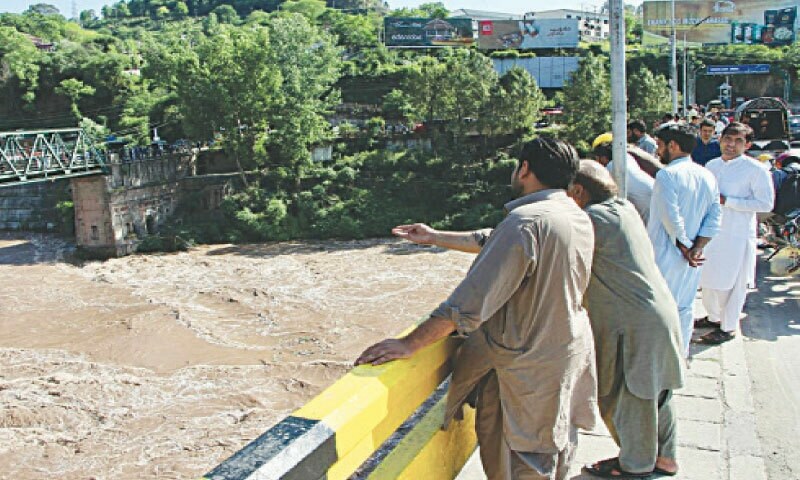

• Met official claims rise is part of usual seasonal flows
• Commissioner says flood wave passes Muzaffarabad without causing damage
LAHORE/MUZAFFARABAD: An unusual surge in the water level of River Jhelum — attributed by officials to snowmelt but feared by locals as flash floods released by India after suspending the Indus Waters Treaty (IWT) — has triggered panic among the residents of Muzaffarabad and surrounding areas.
“A rise in the water level in River Jhelum at Muzaffarabad was recorded, leaving residents panicked. They thought it was a flash flood released by India upstream,” a local resident told Dawn. “People kept watching the river, trying to check if any debris had come, like it does during flood seasons, but they couldn’t find anything,” he added.
A daily water situation report issued by the Water and Power Development Authority (Wapda) also confirmed an increase in water flow levels in River Jhelum. However, an officer from the Met Department’s Flood Forecasting Division (FFD) dismissed the concerns, stating the rise was part of usual seasonal flows.
“Typically, these days we see up to 50,000 cusecs in River Jhelum. As of now (April 26), we have 47,000 cusecs, which doesn’t even qualify as a low flood in the river,” Akhtar Mahmood, the FFD deputy director, explained to Dawn on Saturday. “A low flood in River Jhelum ranges between 75,000 and 110,000 cusecs,” he added.
He further clarified that water levels in all rivers typically rise during this period due to snowmelt and rainfall in the catchment areas. “The water level in River Jhelum at Manga always rises this time of year (until June 15) due to snowmelt, followed by monsoon rains. Similarly, water rising in the Indus at Tarbela is 80 per cent due to snowmelt,” he said.
“At times, the rise in Jhelum’s water level could also be due to the cleaning of a mini-reservoir at the Kishanganga run-of-the-river hydroelectric project. But I believe this rise is due to increased temperatures melting snow,” he concluded.
Unusual surge
The Muzaffarabad division commissioner said on Saturday that an unusual surge in the flow of River Jhelum was recorded after India released water into the river.
Speaking to Dawn, Chaudhry Guftar Hussain said that while the normal flow of the river in Muzaffarabad remained around 18 cumecs (cubic metres per second), it swelled to 26.4 cumecs at around 12:15pm. However, the flow reduced to 22 cumecs within an hour, he added.
Despite the sudden increase, the flood wave passed through the territorial limits of Muzaffarabad without causing any loss or damage, he said.
Mr Hussain said that so far, no adverse impact had been reported from the low-lying areas adjacent to the river, which are generally vulnerable to such surges. Nevertheless, he advised residents to continue exercising caution, particularly while moving near the riverbanks, as a preventive measure.
Water release
The Indus River System Authority (Irsa) on Saturday released 118,500 cusecs of water from various rim stations with inflow of 129,400 cusecs, APP reported. According to data, the water level in River Indus at Tarbela Dam was 1431.43 feet, which was 29.43 feet higher than its dead level of 1402.00 feet. Water inflow and outflow in the dam was recorded as 39,100 cusecs and 43,300 cusecs, respectively.
The water level in River Jhelum at Mangla Dam was 1129.60 feet, which was 79.60 feet higher than its dead level of 1,050 feet. The inflow and outflow of water was recorded 47,100 cusecs and 32,000 cusecs, respectively.
The release of water at Kalabagh, Taunsa, Guddu and Sukkur was recorded as 62,700, 44,300, 34,800 and 7,400 cusecs, respectively. Similarly, from River Kabul, 22,400 cusecs of water were released at Nowshera and 12,500 cusecs from River Chenab at Marala.
Published in Dawn, April 27th, 2025





